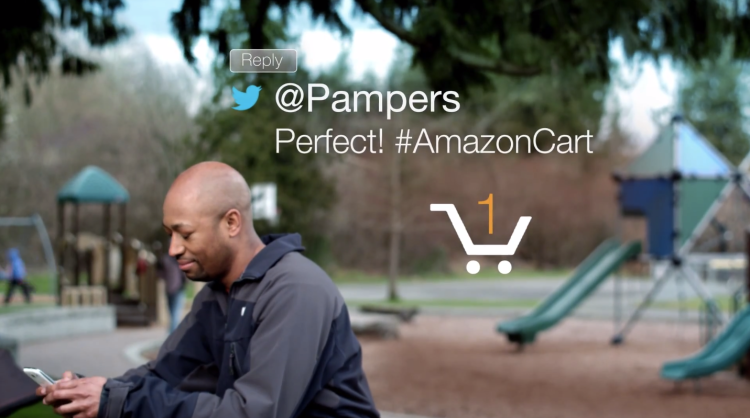In September 1999, the United States Patent and Trademark Office issued US patent 5960411, titled, “Method and system for placing a purchase order via a communications network.” The applicant, Amazon.com, was awarded the patent for devising a way to complete an online purchase the moment an item was added to a cart.
Rather than require customers to enter payment information at every checkout, “one-click buying” made the online buying process easier. It was revolutionary. One-click was a major force behind the rise in popularity of e-commerce in the early 2000s, and Amazon is still reaping the benefits today.
What Amazon just announced last month, however, will be even bigger.
The #AmazonCart
In early May, Amazon pulled back the curtain on a joint initiative with Twitter called #AmazonCart (or #AmazonBasket in the U.K.). Using the simple hashtag, you can now add items to your Amazon cart directly from a Tweet and finish up the checkout process on Amazon.com at your convenience.
While social selling has been steadily growing for years, Amazon’s entrance on the scene is like an elephant jumping into the kiddie pool.
Until now, selling on Facebook, Instagram, and Twitter has been mostly the secret weapon of forward-thinking boutiques and innovative brands. But with over 230 million products currently in its catalog, Amazon has just made the world’s largest inventory shoppable with a hashtag. And you can bet it’s going to cause a wave.
Now, anywhere and anytime they have access to Twitter, Amazon customers can purchase a new pair of dress sandals, the perfect serving bowl for their summer cookout, or a bestseller for their trip to the beach.
Critics Are Missing the Point
Still, the reactions to #AmazonCart have been surprisingly mild, if not downright dismissive. After being out-maneuvered by Amazon in the past, you would think other retailers would pay closer attention.
One of the most common criticisms has been that #AmazonCart, and all social selling for that matter, isn’t much faster than just clicking through to the store.
The notion is that clicking on a link, finding the right item, and pushing ‘Add to Cart’ is so painless that we really don’t need to shorten the sales funnel by a single step. Are we so impatient that now is no longer soon enough?
Those observations are technically correct, but they’re missing the point.
Over the past 20 years we’ve gotten so used to the experience of sterile, white product grids, shopping carts, and checkout buttons, that we assume it’s still the best way to sell goods online. With 68% of interested buyers dropping out at some point along that funnel, are you really willing to assume that?
What if your customers would prefer to not go through a “sales funnel” at all?
A Better Shopping Experience
With #AmazonCart, customers are finally able to buy something the moment it’s being offered to them and then get on with their day. If the product interests them and the price is right, they can close the deal without needing to navigate the giant Amazon.com warehouse.
The process is seamless, just like buying in real life. No sales funnel, just a handshake and an exchange. Search “#AmazonCart” on Twitter right now and you can see a dozen of these deals that have gone down in the time it’s taken you to read this far.
And contrary to expectations, this style of real-time buying actually leads to fewer phony offers, not more.
Looking Beyond The Funnel
Although #AmazonCart currently requires customers to log onto the site to complete a purchase, soon Amazon will be able to let them confirm with an email, an SMS, or even a thumbprint. And if the deals aren’t already inked, it won’t be long before #AmazonCart is integrated across Facebook and Instagram, too. This is when it starts to get really interesting.
If one-click buying was able to revolutionize e-commerce 15 years ago by removing a single step from the sales funnel, what will it look like when it finally disappears completely? When retailers and their customers are doing business in real time over mobile and social media?
When you sell through a tweet — or a Facebook comment or Instagram photo — there’s no limit to the amount of creativity that can go into displaying your products. Forget the white grid of products you’re used to. Anything you currently post to social media with the intention of getting a “Like” suddenly becomes a way to generate sales.
Videos, GIFs, lookbooks, customer reviews — they’re are all potential sales drivers. Was a celebrity spotted carrying your new handbag? Tweet a photo of it and watch the orders roll in.
Social selling is truly the best for all parties. Customers enjoy the more personal, real-time experience, and retailers can customize when and how products are sold. It may not resemble the online selling of 20 years ago, but it’s certainly the online selling of the future.
The only question is, will Amazon be the only one to lead the way?
Chris Bennett is the co-founder and CEO of Soldsie, the world’s first social shopping service. Follow him on Twitter here.


